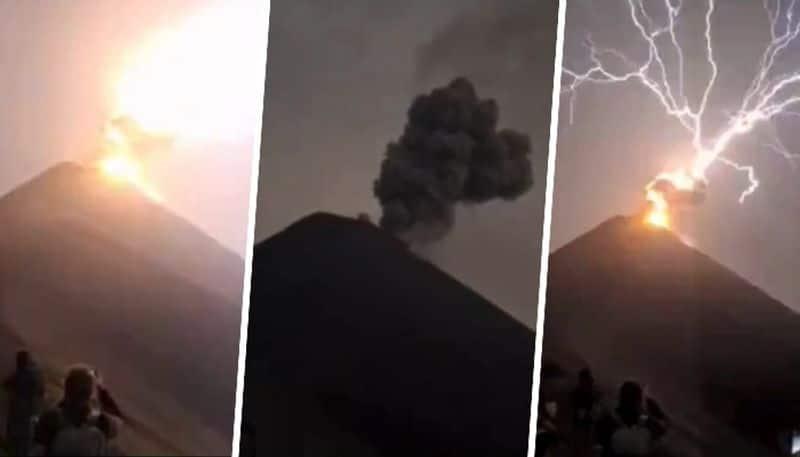
UNBELIEVABLE! Lighting Dramatically Illuminates World's Most Volatile Volcanoes In Guatemala (WATCH)
As the volcano unleashed its fury, a storm brewed overhead, setting the stage for a breathtaking spectacle. Lightning flashes intermittently illuminated the darkened sky, adding an electrifying element to an already awe-inspiring scene. Cameras clicked rapidly as the crowd watched in wonder, capturing the rare convergence of natural forces.
One particularly striking moment occurred when a bolt of lightning appeared to stretch from a cloud, branching out like a spiderweb before exploding in a burst of light. The thunderous echoes reverberated across the landscape, mirroring the collective astonishment of the onlookers.
Photographs and videos of the event quickly circulated on social media, with one photographer expressing incredulity at the odds of capturing such a remarkable occurrence. However, scientists explain that the phenomenon is more common than one might think.
Volcanoes, it turns out, have the ability to generate their own lightning. This phenomenon occurs as different-sized particles of ash within the eruption cloud collide at high speeds, creating static electricity in a manner akin to rubbing a balloon on fabric. The resulting separation of charges within the volcanic cloud can lead to lightning strikes, adding another dimension to the already tumultuous volcanic activity.
Scientists at the University of Hawaii's Center for the Study of Active Volcanoes shed light on the process, likening it to the dynamics of a thunderstorm. Just as friction between air masses can produce lightning in a storm cloud, the collision of volcanic particles within an eruption cloud can generate similar electrical discharges.
Further analysis of the viral footage by FOX Weather Senior Producer and Meteorologist Greg Diamond supports this explanation. Diamond's examination of the video frames suggests that the lightning originated within the ash cloud itself, adding clarity to the sequence of events captured by the camera.
According to the National Institute of Seismology, Volcanology, Meteorology, and Hydrology of Guatemala, the erupting volcano propelled a towering column of ash, particles, and heated gas nearly 1,000 feet into the air, with debris dispersing over a distance exceeding 18 miles. A study conducted in 2013 revealed that electrically charged ash particles can travel hundreds of miles away from the volcanic vent.
"When the opposite charges build up enough, the insulating capacity of the air breaks down and there is a rapid discharge of electricity that we know as lightning," wrote NOAA's National Severe Storms Lab. "(The actual breakdown process is still poorly understood.) The air breakdown creates ions and free electrons that travel down the conducting channel."
According to NOAA, the conducting channel through which lightning travels is typically only an inch or two in diameter. In the case of ash plumes and the majority of thunderstorm clouds, the lightning flash comprises a series of negatively charged stepped leaders. These leaders extend outward in rapid succession, covering approximately 150 feet with each step, as they seek a positively charged surface.
Approximately 450 feet away from the positively charged area, the leader makes contact with a developing positive charge, often referred to as an upward streamer. When these two elements finally merge, the outcome is explosive. This connection establishes the conductive pathway necessary for the rapid discharge of electricity, resulting in the dazzling flash of lightning.
"They essentially acted as stepped leaders and when they connected with the positive charges within the storm cloud, it led to the massive return stroke," said Diamond in a FOX Weather report.
The human eye is incapable of discerning the rapid movement of stepped leaders, which travel at speeds of around 200,000 miles per hour.
"The highly visible return stroke moves upward through the leader channel at about 200 million miles per hour," the NWS was quoted as saying. "The combination of the stepped leader and return stroke happens in just a fraction of a second."
During a volcanic eruption, what the human eye perceives is the resulting discharge-a bolt of lightning that appears to flicker in the sky.
In a study conducted during the 2018 eruption of the Fire Volcano, scientists observed a sequence of events that unfolded over several hours. The eruption commenced around 2 p.m., with ash emissions becoming visible before 5 p.m. The first occurrence of volcanic lightning occurred at 6:14 p.m., continuing intermittently until 10 p.m. Throughout this period, researchers documented a total of 75 distinct flashes of lightning.
Tragically, the June 3, 2018 eruption of the Fire Volcano had devastating consequences. According to Guatemalan authorities, the eruption claimed the lives of 165 individuals, while an additional 260 individuals remain unaccounted for, underscoring the profound impact of volcanic activity on both human lives and communities.
Legal Disclaimer:
MENAFN provides the
information “as is” without warranty of any kind. We do not accept
any responsibility or liability for the accuracy, content, images,
videos, licenses, completeness, legality, or reliability of the information
contained in this article. If you have any complaints or copyright
issues related to this article, kindly contact the provider above.















Comments
No comment